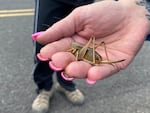
April Aamodt holds a Mormon cricket in her hand in Blalock Canyon near Arlington, Oregon, in mid-June. Aamodt is involved in local outreach for Mormon cricket surveying.
Claire Rush / AP
We’re staring down another summer of drought conditions across much of central and eastern Oregon. Years of hot, dry weather in those areas has created fertile conditions for swarms of insects like grasshoppers and crickets.
It’s bad news for farmers and ranchers already struggling with drought. In 2021 alone, Oregon, agriculture officials estimate 10 million acres of rangeland in 18 counties were damaged by bugs.
Seriously: They’re everywhere.
In this video by April Aamodt, thousands of Mormon crickets cover the streets in Arlington, Oregon.
The population of Mormon crickets has exploded in recent years in Eastern Oregon’s Gillam County. Now, the Oregon Department of Agriculture is supporting local volunteers who are taking measures into their own hands, to fight back against the pests.
OPB Weekend Edition host John Notarianni recently talked with Jordan Maley, an Oregon State University Extension agent who has been organizing volunteer efforts to combat swarms of Mormon crickets, and April Aamodt, a resident of Arlington, Oregon, who has helped lead the community fight against the pests.
John Notarianni: I’m guessing battling crickets wasn’t a responsibility you expected when you signed on as an extension agent with OSU. What kinds of problems do these Mormon crickets cause?
Jordan Maley: Basically what happened, in 2017 in the summer is that they moved into downtown Arlington. They moved from adjacent rangeland areas where they had sort of been building up. And so, when they showed up in downtown Arlington in the thousands, it was, yeah — we just had to totally do something new that we had never done before. And so, we just took the challenge on.
Notarianni: And real quick, Mormon crickets: What’s up with that name?
Maley: It’s a misnomer; they are actually a shield-backed katydid. It originates from the outbreak in Salt Lake City, Utah, way back in the 1880s, I believe.
Notarianni: April, you’ve gained the nickname of being the “cricket queen” for the volunteer work that you’ve done organizing and combating these insects. Why did this become such a passion project for you?
April Aamodt: When they entered Arlington, they came up the street. They were marching up the street and they covered my home. And so I didn’t have anything to fight them with.

April Aamodt holds a Mormon cricket that she found in Blalock Canyon near Arlington, Ore. on Friday, June 17, 2022, while OSU Extension Agent Jordan Maley, far right, looks at more of the insects on the road. Both are involved in local outreach for Mormon cricket surveying.
Claire Rush / AP
Notarianni: And when you say covered, what do you mean? How many crickets are we talking about?
Aamodt: Well, when Jordan says thousands, it’s more like you have a million crickets everywhere. Your whole house is covered, and they crawl up your chimneys. They like a heat source, so they crawl on anything that’s cement. And so when you’re battling those, trying to keep them from getting in your house or laying eggs on your lawn, I always compare them to a tube of lipstick. I actually have a picture where they’re the size of a tube of lipstick.
I was able to get a backpack sprayer and sort of get everything calmed down at my house, and then joined together with other groups in Arlington after work. We would get together and go help our neighbors.
Notarianni: Jordan, do we have any sort of sense of why these outbreaks are happening in places like Arlington now?
Maley: They’re cyclical, but these mega-cycles of outbreaks are usually related to severe drought. And our current outbreak was at the end of a fairly long drought cycle in North Central Oregon and Eastern Oregon.
Notarianni: Part of this eradication strategy does involve the use of spraying aerial pesticides. That’s caused concern among some environmental and conservation groups. Last month, the Xerxes Society for Invertebrate Conservation and the Center for Biological Diversity filed a lawsuit against the USDA agency that authorized the practice. I’m wondering for you, are you worried about the risks of applying these chemicals to thousands of acres of land?
Maley: Honestly, I’m not. I’m fairly conservative about the use of pesticides, so I looked into diflubenzuron and, really, the recommendation came from the Oregon Department of Agriculture to use this. It’s an insect growth regulator. And then, of course, we just do due diligence. We have a notification system and we work with the wind farms. We work with the farmers and ranchers. We notify the road department crews because we don’t want people out there during the spraying operation even though the material is indicated, by the label, as safe. We simply don’t want that to happen.
Notarianni: Well, we have had a wet, cool spring so far this year. I’m wondering, in your survey, has that mild spring had any impact on the cricket populations in your region?
Maley: It delayed things. It’s been such an unusual spring. And for Mormon crickets, unlike grasshoppers, a wet, cool spring doesn’t affect them in terms of physiologically, but it does delay their development because it’s all temperature driven. So yeah, it slowed them down a little bit.
Notarianni: What’s the long-term goal here? I mean, do you think you’re going to be able to get to a point where we can actually stop these swarms of insects? Or do you think it’s something we’re just going to need to live with maintaining every summer for the foreseeable future?
Maley: Our goal is not eradication. We need to make that clear. I’m hoping that it isn’t every summer. I’m hoping that, because we’ve been very proactive since 2017 in trying to manage these, that we could kind of take the peak off of this outbreak and get back to a steady state of Mormon crickets being out in the environment, like they have been for probably eons. I think we’ve been proactive enough over the period of time – we got right on it. I think we’re going to be okay.
Notarianni: What about you, April: you’ve been living with these Mormon crickets every summer. What does the long-term solution to the problem look like for you?
Aamodt: I think, long term, it is exactly what Jordan was talking about. It’s being proactive and going out every year and scouting for crickets. ... We’ve had goats in Arlington and chickens eat them.
Notarianni: People are selectively getting these animals with the express purpose of eating crickets?
Aamodt: Two people did, and they worked pretty good. But that is a natural way to control them, and if we can do it naturally, we want to do it that way. It’s just when there’s such large numbers, there’s no way to control them without using some kind of aerial spray.
